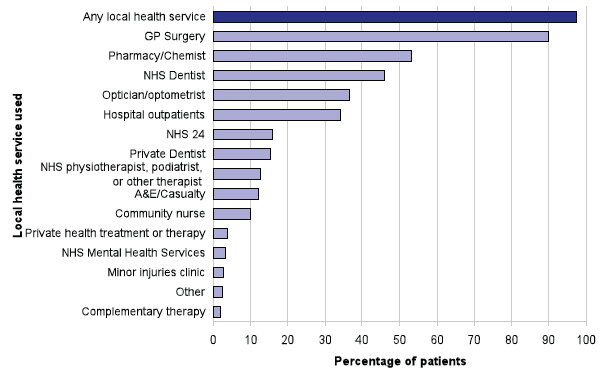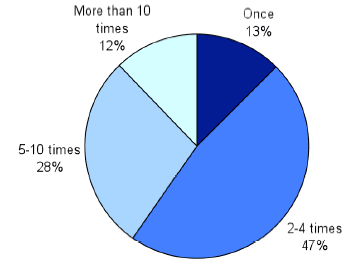Patient Experience survey of GP and local nhs services 2011/12 Volume 1: National Results
Scottish Patient Experience Survey of GP and Local NHS Services 2011/12. This is a postal survey which was sent to a random sample of patients who were registered with a GP in Scotland in October 2011. This report contains the national results, comparisons between NHS Boards and international comparisons.
This document is part of a collection
3 GP Practices - Getting to see or speak to someone
Summary
3.1 In total 75 per cent of people rated the overall arrangements for getting to see a doctor as good or excellent, although this was six percentage points lower than in 2009/10. Most people had a positive experience of phoning their GP surgery, both in terms of getting through on the phone and speaking to staff. Almost 8 out of 10 patients who attended surgeries with more than one doctor were able to see the doctor they preferred. More information on these results and other questions relating to accessing local health services are outlined below.
Use of local health services
3.2 Respondents were asked to indicate from a list which local health services they had used in the last 12 months. Ninety seven per cent of people who returned the survey had used at least one local health service in the last twelve months.
3.3 Of those who used a local health service
- 90 per cent used GP surgery services
- 53 per cent used pharmacy/chemist services
- 46 per cent used NHS dentist services (Chart 1).
Chart 1: Local services used in the last twelve months

How often people contacted their GP surgery
3.4 Of people who could remember how many times they had contacted their GP surgery:
- 47 per cent contacted it two to four times during the last 12 months
- 40 per cent contacted it five times or more in the last 12 months (Chart 2).
Chart 2: How often patients contacted their GP surgery in the last twelve months

Phoning the GP surgery
Getting through
3.5 Patients were asked how easy it was for them to get through on the phone the last time they had contacted their GP surgery.
3.6 Of patients who remembered their last experience of phoning the surgery:
- 85 per cent found it very easy or fairly easy (44 per cent responded very easy and 41 per cent fairly easy);
- 15 per cent responded they did not find it easy (Chart 3).
Chart 3: Getting through on the phone

Helpfulness
3.7 Patients were asked 'The last time you phoned the GP surgery, how helpful was the person who answered?'
3.8 Of the patients who remembered their last call:
- 95 per cent found the person who answered very helpful or fairly helpful (66 per cent responded very helpful and 29 per cent fairly helpful);
- 5 per cent responded that the person who answered was either not very helpful or not helpful at all (Chart 4).
Chart 4: How helpful was the person who answered the phone at the GP surgery?

Surgery opening hours
3.9 Patients were asked what they thought of the opening hours of their GP surgery.
- 80 per cent were happy with the opening hours;
- 11 per cent found it too difficult to get time away from work during opening hours;
- 2 per cent responded that the opening hours were not convenient for another reason;
- 8 per cent did not know what the opening hours were.
Two working day access to see a doctor or nurse
3.10 Often a patient's first and only contact with the NHS is through their GP practice. It is vital, therefore, that every member of the public has fast and convenient access to their local primary medical services to ensure better health outcomes and a good patient experience. Every NHS Board in Scotland is required to meet a HEAT3 standard that monitors the percentage of patients able to obtain access within two working days and book an appointment in advance to an appropriate healthcare professional. GP practices are expected to provide reasonable appropriate access for their patients as part of their services.
3.11 In the survey patients were asked, when they had needed to contact their GP surgery quite urgently, if they had been able to see or speak to a doctor or nurse within two working days.
3.12 Of those patients who were able to remember:
- 85 per cent could see or speak to a doctor or nurse within two working days compared to 90 per cent in 2009/10.
3.13 Until 2010/11 GP practices were allocated some funding based on the percentage of their patients able to obtain 48 hour and advance access. The decrease in the percentage of patients able to get 48 hour access is the second largest (5 percentage point) found in this survey compared to the 2009/10 results, the largest being for the overall arrangements to see a doctor (6 percentage point reduction). The reasons for this large decrease are not clear and to understand them fully would require further detailed exploration; however in the absence of financial incentives targeting 48 hour access, practices may have focused on other aspects of quality. For example there was a 3 percentage point increase in the percentage of patients who felt that they had enough time with their doctor.
3.14 Of those 15 per cent who were unable to see or speak to a doctor or nurse within two working days:
- 45 per cent said they had not been offered a chance to see or speak to anyone within two working days;
- 38 per cent reported that the person they wanted to see was not available in the next two days;
- 12 per cent reported that the times available were not suitable for them;
- 5 per cent were unable for another reason.
3.15 For the HEAT standard we count patients as being able to obtain two working day access if they were offered an appointment, but the person they wanted to see was unavailable or the time did not suit them.
- 93 per cent of patients were able to see or speak to a doctor or nurse within two working days, or were offered an appointment but either the person they wanted to see was unavailable or the time was not suitable. This is two per cent lower than in 2009/10.
Book an appointment in advance
3.16 Patients were asked if their GP surgery allowed them to make an appointment with a doctor three or more working days in advance.
- 24 per cent of patients said they did not know if they could book an appointment 3 or more days in advance;
- Of those who did know, 80 per cent responded that their GP practice allowed them to book an appointment three or more working days in advance. The remaining 20 per cent responded that their GP practice did not allow them to.
Preferred doctor
3.17 The survey asked patients if they usually saw the doctor they preferred when making an appointment.
- For patients at GP surgeries where there is usually more than one doctor, 21 per cent of patients indicated that they do not have a preferred doctor. This percentage remains the same as in 2009/10.
- Of the patients who have a preferred doctor, 79 per cent reported that they are usually able to see the doctor that they prefer. This is a one percentage point decrease compared to 2009/10.
Overall arrangements to see a doctor or a nurse
3.18 Patients were asked to rate the overall arrangements for getting to see a doctor and/or a nurse in their GP surgery. Patients rated the overall arrangements for getting to see a nurse better than for doctors.
- 75 per cent of patients rated the overall arrangements to see a doctor as excellent or good compared to 81 per cent in 2009/10;
- 8 per cent of patients rated the overall arrangements to see a doctor as poor or very poor compared to 6 per cent in 2009/10.
- 84 per cent of patients rated the overall arrangements to see a nurse as excellent or good compared to 87 per cent in 2009/10;
- 3 per cent of patients rated the overall arrangements to see a nurse as poor or very poor compared to 2 per cent in 2009/10.
Contact
Email: Gregor Boyd
There is a problem
Thanks for your feedback